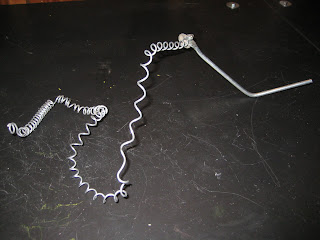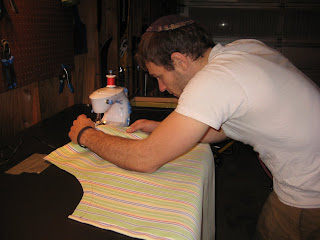My bedroom had a very old, dim and
unattractive light fixture that didn't really properly illuminate the room at night, so I wanted to make something a little brighter. The designed I came up with features light bulb sockets floating at the end of flexible
moldable arms extending from the base of the fixture. My original idea was to use flexible conduit for these arms, but they didn't seem up to the task of holding their shape. Instead I decided to use some 1/2" vinyl tubing and just rely on the
Romex to provide the shape. After I had the thing built, it turned out that the
Romex wasn't stiff enough to hold up the weight of the bulbs, so I needed to come up with a little something more. I just put in a section of coat hanger and then it worked beautifully.
All the parts laid out ready for construction.

My first step was to insert the light bulb socket into the PVC nipple. These to parts are not designed to go together so it took a little coercion. Ultimately I felt that this junction was not secure enough so I went over it with some Goop and felt much better about it.

Next, I fed the Romex through a section of vinyl tubing and connected it to the leads from the socket. Note that I carved the wings off of the yellow wire connectors so that they will fit inside the tubing. Also for the same reason, I staggered the junctions so that they aren't right next to each other (you'll see why in a minute).

I next wrapped the connection up with electrical tape just to keep it as a tight little package to help me get the tubing over it.

With a tiny squirt of WD-40 I was able to slip the tubing sections over the wire connection I had made and onto the end of the PVC nipple.

To attach the 'arms' to the base, I needed a very bizarre adapter to go from the vinyl tubing which was in the plumbing department to the handy box which was in the electrical department. It turned out that the exact piece I needed exists and was in found in the electrical department. It's a 90° PVC elbow with a normal conduit termination on one end that can insert into the handy box and then accept a conduit lock nut to secure it into the base. On the other end it has a nipple for the 1/2" vinyl tubing and then a cup that comes over the tubing and threads on to secure it in place. I have no clue what application this part normally has, but I'm glad that it exists.

There's the finished product installed. I mounted a piece of cardboard behind it because the wall is weathered in the shape of the old fixture. On it I wrote the words "יְהִי אוֹר" or "Let there be light". Indeed, the lighting situation is
dramatically improved.







































